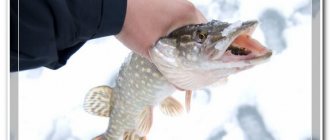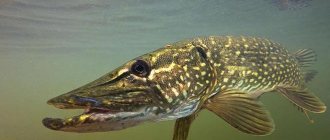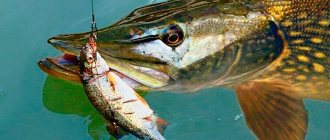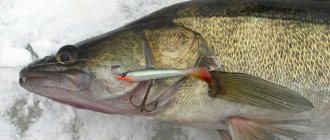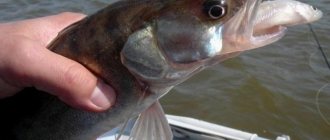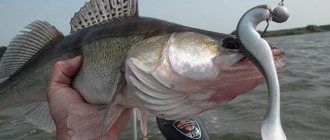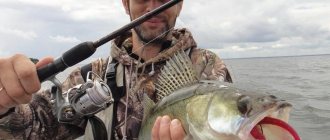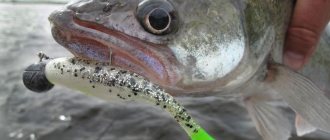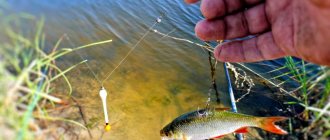When going fishing to catch pike perch using a spinning rod, you need to get to know this predator better; it would be good to know what this fish eats and when it likes to hunt. When choosing a place for spring, summer or autumn fishing, it is better to know the lifestyle of pike perch and at what time of year and with what gear and bait fishing for this predator is more successful. It is also necessary to take into account that during spawning there is a ban on catching pike perch. The ban period in spring usually lasts until the middle or end of June, the date depends on the region and the geographical location of the reservoir; spawning of the fanged predator occurs earlier to the south, and later in the northern regions.
Where to catch pike perch using a spinning rod
In the spring, successful fishing for pike perch with a spinning rod before the fishing ban occurs only in pits and pools, where there is a lot of this fish, but even here this fishing is very short-lived and lasts several days, no more than a week. It is caused by the fact that when the river opens, this predator, along with pike and large perch, and sometimes catfish, gathers from almost the entire area into the pool and feeds here on fish carried away by the flow of water. All these predators, not allowing the fish as it slides down to recover from the rapidity of its movement, grab it in flight, sometimes on the surface of the water. With such an abundance of food in the spring, pike perch are difficult to catch using spinning rods.
Catching pike perch in the summer with spinning rods, circles and nets is practiced mainly in large pools, and in general deep river holes, littered with various snags and old trees that serve as an ambush. In other places it is rarely found, although small pike perch, up to 400 grams, are sometimes caught in large numbers along with perches using a worm rod. Large pike perch is a very strong and lively fish, since it lives in even harsher places than perch, its fishing requires strong tackle, as for pike, a strong and durable spinning rod.
Habitats
Let's consider all the places where pike perch live in large numbers, depending on seasonality:
- In early spring, while there is no fishing ban, the predator can be found in holes or fairly deep pools. This location is due to the fact that the current carries all the fish that this predator hunts into this part of the reservoir. Therefore, when fishing here, you can catch not only pike perch, but also pike, catfish and others. But still, the bite on a spinning rod will not be too intense due to the abundance of food in the spring.
- In the summer, it is better to fish with a spinning rod in fairly large pools and deep holes in the river. There are many old fallen drowned trees here, which the predator uses as a place to organize an ambush. Therefore, the bite here will be most intense compared to other places in the river.
Spinning rod for pike perch for casting
You can catch pike perch using a spinning rod and cast almost all year round, even in winter, if there are open areas of water, with the exception of the ban on fishing in the spring during the spawning period. These predatory fish can live and be found both in still water and on rivers with significant currents, and also taking into account that the fish can be caught quite large, the choice of rod is varied, one for some conditions, and another for other conditions. You should choose a spinning rod for catching pike perch depending on the fishing conditions, fishing from a boat or from the shore, whether there is a current or not, and you should also choose a fishing rod taking into account the weight of the spoon, jig head, wobbler or other bait.
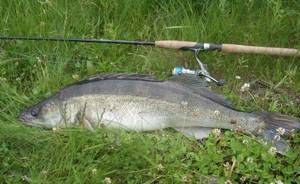
If you have to catch pike perch using a spinning rod while casting on a new body of water with an unknown bottom topography, it is better to have two or three spinning rods with you that are different in length, test and structure for the weight of different baits and for different retrieves. In general, catching a fanged predator using a spinning rod and casting is more interesting than passive methods of catching pike perch by trolling with a wire, or even more so by fishing with live bait.
Among fishermen who prefer casting with a spinning rod, fishing for fanged fish on a jig head using various silicone and other soft baits predominates to a greater extent. This is explained by the fact that pike perch spend most of the year, especially in summer, from the second half of summer until autumn in holes and pools at a depth near the bottom, or at the edge level. Therefore, it is better to catch it with baits passing near the bottom.
Choosing a spinning rod for jigging is a different story, as there are quite a lot of options. And yet, when fishing with jigs, it is very important that the structure and test of the spinning rod correspond to the weight of the selected bait with a jig head. In order to be able to clearly feel the movement and impacts of the bait on the bottom, and even more so to feel the bite of a predator. When fishing in a current, the weight of a jig head can be 15-30 grams, and in calm and still water, the weight of a jig can be 5-10 grams, and spinning rods should be accordingly different in test.

Pike perch is a predatory fish that, when casting from a boat or shore, actively takes both wobblers and spinners. It is better to choose a spinning rod for casting a wobbler or spinner for pike perch that is longer in order to cast the bait further, especially the wobbler. Since wobblers usually have a large windage and low weight, it can be very inconvenient to throw them, especially over long distances. And therefore, it is better to take a spinning rod for casting a wobbler with a length of 2.7-3.3 meters, medium hard and with a dough that is naturally designed for the weight of the bait.
Where to look for pike perch in open water
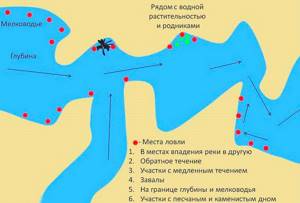
Without knowing the habitats of pike perch in a pond, there is nothing to do. You will be like a blind kitten, poking your face into the unknown. This will not bring pleasure and results.
The fish may practically not move and remain in one position, occasionally making a promenade:
- To the shallows.
- To the edge.
- And then, return to the starting position.
We recommend reading: Catching pike with a wobbler
Pike perch prefers sharp edge transitions, rifts, channel slopes, and areas with frequently and chaotically changing bottom topography. It can stand in snags or be in deep holes - these are the predator’s favorite places. They are the ones that need to be fired at periodically.
Note! Pike perch will not be found in areas with muddy or blooming water. The fish prefers clean, oxygenated water and areas with a sandy, rocky bottom.
On the boat
In this case, a long spinning rod is not needed. You can use a 2.1 meter fast action stick. The power reserve for the forced intake of the predator is important. Often, when spinning fishing for pike perch from a boat, a jig kit is used.
From the shore
For working from the coastline, rods of 2.7 meters with fast or medium-fast action are suitable. Power reduction – 1:5.0. Cord diameter: 0.1-0.18 mm. The breaking load and good abrasion resistance of the cord are taken into account. A steel or, less commonly, a fluorocarbon leader is used.
Spinning rod equipment for pike perch
It is better to equip a spinning rod for casting pike perch with a spinning reel or a multiplier casting reel. But fishing with a baitcasting reel is more difficult, since if the settings are not correct and without experience in use, when casting, there is a high probability of a beard appearing on the reel, and then a long and tedious unraveling of the fishing line. And it is also necessary to take into account that a good quality multiplier casting reel is much more expensive than a spinning reel.
It is better to choose a spinning reel that is also durable and of high quality, size 2000-4000, depending on the test of the spinning rod and the bait. To equip the reel, you can wind a fishing line with a diameter of 0.27-0.35 mm or a cord 0.8-1.2 (0.14-0.20 mm thick), whatever is convenient for you and always taking into account the characteristics of the fishing rod.
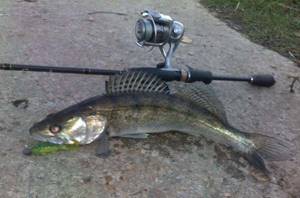
It is better to fasten the bait to a fishing line or cord using a metal leash with a clasp. It is preferable to use a titanium leash, without memory, 15-20 cm long. Because when casting, a pike can bite and cut off your favorite and expensive wobbler or spinner with its teeth. And be sure to remember to install a swivel between the fishing line and the leash.
Jig baits, wobblers and spinners for pike perch
Pike perch baits for jig heads can be varied in color, shape and weight, usually it is soft rubber made of silicone, even with a smell and edible. Rubber comes in a variety of forms, including worms, vibrating tails, twisters, crustaceans and other forms. The colors of pike perch jig rubber can work in different ways, it’s better to try options of different shapes and colors, and also a lot depends on the wiring of the jig, so the main thing when catching pike perch with a spinning rod is to hold the bait so that the predator wakes up the hunter’s reflexes and rushes after the prey.
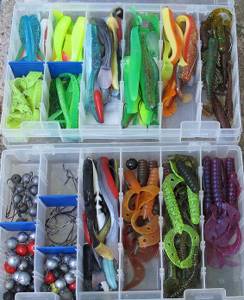
There are also many models of zander wobblers specifically for casting, which, due to their design, fly smoothly and far, but it is not always these wobblers that end up in the fisherman’s box. If the rod is correctly selected for casting, then throwing wobblers for fishing into the line and for trolling will not be difficult. Wobblers and spinners for pike perch when casting with a spinning rod work in the same colors as when fishing by trolling, the main thing is to choose the depth of the wobbler so that the bait passes at the depth and level of the fanged fish.
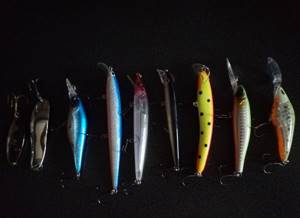
Therefore, when casting, it is better to take a wobbler that is sinking or neutrally buoyant (suspending), although floating wobbler models also work when casting.
Choosing a place to catch pike perch
Pike perch is a predatory inhabitant of medium and large waterways of our country. It lives in large rivers, lakes, and reservoirs. This fish does not like muddy bottoms and prefers to be on a hard surface covered with pebbles or shells. This predator also tries to avoid visiting places that are poorly saturated with oxygen and settles in clean water with the current. Pike perch likes to rest in places with stumps and snags, where you can safely hide from more dangerous predators - catfish and pike. Also in such places you can take a break from the current and use them for ambush.
Pike perch is a typical predator of the menu, which consists almost 100% of small fish. Its diet includes fry of all representatives of the reservoir where it lives. In addition to the fry, the predator likes to feast on all types of insects and their larvae, sometimes even pecks at a worm; the predator also feeds on crustaceans and mollusks. It does not disdain invertebrates living at the bottom of the reservoir.
These predators usually live in packs, and the smaller the size of the individuals, the larger the pack. Small specimens can form flocks of up to 20-50 or more. Large individuals gather in groups of no more than 6-8. Sometimes captured specimens cost one at a time, but these are extremely rare cases.
In the early morning or late evening you can see the “fight” of this hunter. This happens because basically this predator does not like hunting from cover, preferring to quickly pursue prey that catches its eye.
Choosing equipment for catching pike perch using a spinning rod
- 1. The spinning rod for fanged fishing should be light so that the hand does not get tired during the fight. Length from 2.5 to 3 meters. The structure of the blank should be such that you can make long casts. When fishing, you should most often use braided fishing line because it is the most durable.
- Lures for catching pike perch using a spinning rod
There are a huge number of baits for catching pike perch. The predator is tempted by almost any type of bait, from animals (insects and larvae, small fish, crustaceans and shellfish) to various types of artificial bait that can be bought in the store. You can also make your own baits.
When silicone appeared in the fisherman’s arsenal, various simulators of animal baits immediately appeared, and they were made with such similarity that the fanged fish took them with great eagerness. The predator is attracted not only by the appearance and color of the baits, but also by their ability to imitate the movements of animal prey, pike perch. The advantage of such attachments is their low price.
1. Vibrating tails.
Lures for fanged fish in the form of a vibrotail are the most common among others. Vibrating tails for pike perch are distinguished by a narrow shape with a flattened tail in the form of a heel. The vibrotail has this appearance due to the narrow mouth of the pike perch. Typically, a vibrating tail for a fanged fish is never longer than 10 cm or more than 1 cm thick. The color of this bait does not play a big role, but the notches that give the vibrating tail a good sound when playing well affect the bite. Attractants that make the bait edible also have a positive effect on the catch. Vibrotail in appearance imitates fry, which is the main dish of pike perch. This type of bait is mainly used for spinning fishing.
2. Twister
It is distinguished by a wide and thin tail in the shape of a sickle. Like the vibrotail, the twister has a narrow shape; its length varies from 8 to 12 cm. An important characteristic of the twister is the ribbing of the entire body. When wired, the ribbing makes the twister's movements more realistic. This allows you to interest the fish even at a long distance. The color of the twister does not have a big impact on fishing, however, when fishing in places with a high degree of illumination, the color of the twister should be chosen based on the intensity of the light. In gloomy weather, twisters with a brighter color should be used, and in sunny weather, the color should be dark, not flashy.
3. In the category of other silicone baits
there is a huge variety of their forms. These are slugs, creatures and simple silicone worms. Typically, these types of silicone baits are not used often, mainly in cases where the fanged fish begins to be capricious and stops taking the more popular types of baits. Like other types of silicone baits, these are used for jigging in all seasons except winter. Nozzles in the form of frogs and worms are made ribbed. Fishing with such baits involves visual contact with the pike perch, so they are made in bright colors. It has been noticed that pike perch prefers the amber color of the bait on gloomy days and the color of motor oil on clear days. Edible silicone becomes very attractive for inactive fish. They try to use these nozzles in shallow places, where the complexity of their structure brings the greatest results.
4. Wobblers
no less popular when hunting pike perch than silicone, but its significant cost greatly affects the frequency of use. The size of the wobbler can be up to 120 mm, but the diameter does not exceed 3 cm. Using this type of bait allows you to count on catching large and even trophy pike perch. When using wobblers, spinning trolling is usually used.
5. Spoon
. In the classic form, an oscillating spoon is used as bait for fanged fish, although now rotating spoons are no less popular. Also popular are vibrators that are distinguished by their small width and oblong body. The length of the spinner for pike perch is no more than 7 cm with a width of 10-20 mm. The spinner plays without high-frequency vibrations only due to the wiring and has a clear trajectory with small shouts. The castmaster spinner is ideal for this type of fishing. Castmaster is used at great depths; now such spoons are produced with LED backlighting. In shallow water, rotating spoons are used that imitate a willow leaf in shape.
6. Mandula
- a composite nozzle made of cylinders on a metal rod. Most often, the rod for this attachment is an extended tee. The cylindrical components are made of polystyrene foam. Usually there are no more than 5 such cylinders. The mandula is usually decorated in a striped color. This type of bait is usually used for catching pike perch in not very deep reservoirs in the summer and autumn before ice appears on the reservoirs.
7. Foam fish
. An equally interesting type of bait is a foam fish. This bait does not have its own game and its movements depend only on the movements of the spinner. This type of bait is most suitable for jigging and twitching. Pike perch responds well to foam rubber due to the clarity of the trajectories of the movements and the rigidity of the game. Foam fish are baits that are used when fishing only for pike perch. The advantages of foam rubber include its low cost and a large selection of colors and sizes. You can make a foam fish yourself by cutting it out of hard material in shape and size similar to a fry. You need to color it with a felt-tip pen in a suitable color and attach a jig head. This bait is used in any season on water not covered with ice.
8. Balance.
In winter fishing, balancers are used as bait. Balancers are classified as a subspecies of horizontal spinners. It is used at different depths and at different flow intensities. The length of the balancer varies from 5 to 9 cm. It should be taken into account that the larger the balancer, the larger the pike perch that can be caught with its help.
9. Animal bait.
Throughout the year, the fanged fish takes animal bait well. Not only whitebait is the main type of such bait. Maggots, bloodworms, dung worms, leech, and so on are not bad options. During the hatching season, pike perch are excellent at beetles, locusts, and caterpillars; they also love fanged fish and tadpoles, which begin to actively grow in late spring. Among live baits, the best baits are considered to be bleak, loach, gudgeon and roach. Scavengers, crucian carp and silver bream are in less demand, but one should not refuse them, especially if they do not bite on the main types of live bait. Most often, animal baits are used for bottom and float fishing.
10. Plant baits.
The fanged fish is not bad at plant baits either. The baits used are peas steamed in boiling water, pearl barley, corn, and boiled beans will also work. Pike perch take well to plant bait on currents where the bait is constantly moving.
Technique for catching pike perch using a spinning rod
When casting, you should take into account that the fish stands at a distance of 50 cm to 1 meter from the bottom. Therefore, the wiring should be such that the nozzle touches the bottom and immediately rises, and does not drag along it all the time. Immediately after this, you should wind the coil with 2-4 turns.
You need to hook the pike perch sharply, but not sweepingly, and fish it out very quickly, not allowing the pike perch to go under the snag and tangle the line there. Large pike perch must be fished out before hooking, as it can easily break the fishing line.
Posting bait for pike perch
When catching pike perch using a spinning rod while casting, it is necessary to take into account that in holes it usually stands 50-100 cm from the bottom or at the edge level. Therefore, when fishing with a jig bait, the wiring must be such that it does not drag along the bottom when reeling in the reel, but rises up and falls to the bottom again with a pause, then again reeling in 2-3 turns of the reel.
For such bottom bait placement, there is an original way of catching fanged and various other predatory fish, called a drop shot. In this rig, the bait is on the main line at a distance of 50-100 cm from the bottom, and the load is dragged along the bottom, retrieving in the form of a leisurely twitch. There is also a variant of gear with a retractable leash, where the bait is attached to the main line on a leash made of fishing line above the sinker, the length of the leash can be different 20-150 cm. Thus, the bait passes in the layer above the bottom, where the predator may be located, provoking him to bite.
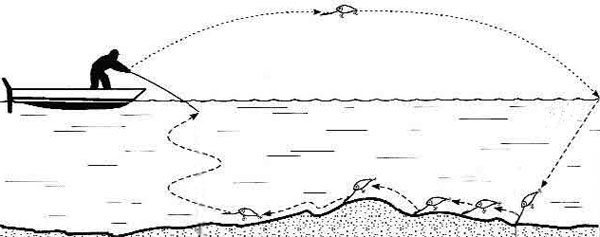
When catching pike perch with a wobbler using a spinning rod while casting, the wobbler must also be held at the bottom in the hole or at the very edge at the exit from the hole. Since the wobbler, due to its parameters, will play itself, the wiring should be leisurely, simply working with the reel, winding the fishing line. And to make the bait look like a wounded fish, you can add movements with the rod, short hooks with the tip of the spinning rod at the surface of the water, periodically reeling in the fishing line. But you definitely need to try different retrieve speeds, since the fish may not react to a bait quietly swimming past it and the bait itself may not attract it. Therefore, it is always better to try different wobblers, spinners and different bait placements.
Hooking and landing pike perch on a spinning rod
When catching pike perch with a spinning rod, you need to hook it with a very fast, but not wide stroke. The main thing is to use a hook to pierce the cartilaginous mouth of the predator, which is not always possible when hooking. Having felt the hook, the pike perch tries to escape and go into the snags at the bottom, so in snaggy places it must be fished out quickly and not allowed to tangle the fishing line.
With a strong fishing line, there is no need to stand on ceremony with a fanged predator and you need to drag it more boldly, not allowing it to come to its senses. Then he walks briskly, only pushing as hard as he can, tugging the rod a little. A very large pike perch sometimes lies on the bottom and moves there so stubbornly that you can’t quickly drag it out of its place. In such cases, in order to stir up the predator and force it to move, it is best to tighten the fishing line and pull it in different directions.
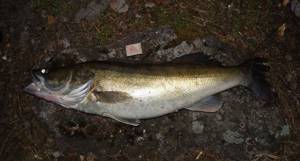
A large pike perch must be fished out and only then reeled in, as it can easily break the fishing line, but as soon as it is taken out of the water, it is completely helpless and falls asleep very quickly. Small pike perch on a thick fishing line can be dragged directly into a boat or to the shore, since outside the water the pike perch usually does not twitch, like perch or ruff.
Choosing a spinning rod for jig fishing
It is not always easy to decide on the choice of spinning rod for jig fishing, since the abundance of products offered for this type of gear is very large and varied.
The main thing in this matter is to decide that the chosen rod provides the opportunity to:
- make long casts with a twister, vibrotail, with a jig head with a weight of about 10 - 40g
- so that the movement of the bait and its contact with the bottom is felt
- so that the weakest biting movements of the pike perch can be felt
- holding the heavy weight of the jig head.
When using a spinning rod with a jig bait, it is planned to carry it out in stages and at great depths. During this process, you need to feel when the bait has hit the bottom and you need to reel in the reel so that the bait continues to move.
Key points when choosing a jig rod:
- quality indicators of the material
- "voice" (sensitivity)
- speed and super-fast construction
- length 2.4 - 3.0 m
- test range from 5 to 40 g
The test range can change in both directions.
Reel and line
For jigging, inertia-free reels are often used; they are not difficult to use, “beards” are rarely formed, and there is a large selection of them.
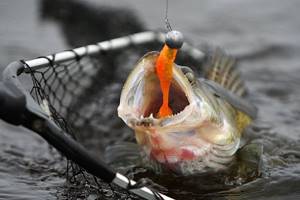
In addition, you need to pay attention to some characteristics of the coil, which you need to focus on when choosing:
- enlarged spool
- equipped with instant reverse stop
- high quality spool and roller
All this is very important, since it involves a large load during wiring and the use of braided fishing line with abrasive properties.
When using inertial coils, preference should be given to multipliers that have high wear resistance and higher sensitivity, allowing the index finger to capture additional information.
The fishing line can be either monofilament or braided. The latter is preferable. The braid does not stretch and transmits information from the bottom in an instant, and a missing memory will not be able to bite the line.
You can choose the thickness of the fishing line in a practical way when assembling all the equipment, taking into account the naturalness and softness of the presentation of the bait. Thin fishing lines are not suitable for these purposes.
The main line needs to be protected with leashes that have an exact breaking load, less than 1/3 of the warp.
